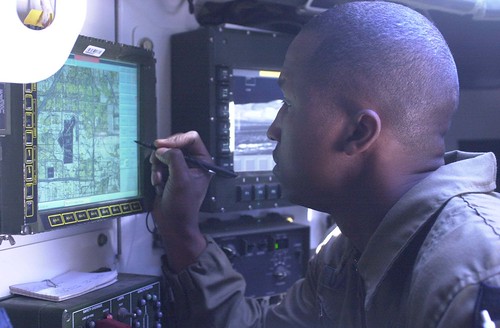Laser-linked Military Satellites — TSAT

Wouldn’t it be great if our enemies stretched dark fiber across the battlefields, if Baghdad linked T1’s to our bases, if an entire fiber optic network was in place—ready for use—before an invasion.
Think again. As our military becomes increasingly relient on network infratructure to share information, to operate weaponry, to plot strategy, it cannot rely on the local library’s free wi-fi. The solution: satellites, of course. Enter the Transformation Communications Satellite System (TSAT)
As video communications is integrated into robots, soldiers, and UAVs, and network-centric warfare becomes the organizing principle of American warfighting, front-line demands for bandwidth are rising sharply. The Transformation Communications Satellite (TSAT) System is part of a larger effort by the US military to address this need.
The final price tag on the entire TSAT program is expected to reach $14-18 billion through 2016, which includes the satellites, the ground operations system, the satellite operations center and the cost of operations and maintenance. By mid-2007, the U.S. Air Force will either decide to build the TSAT system on its current schedule and launch in 2013-2016, or postpone TSAT, take stopgap measures and add Advanced Extremely High Frequency (AEHF) satellites 4 & 5 to the three slated for launch from 2009-2012.
Lockheed Martin and Boeing have won a total of $514 million each in risk reduction contracts for the TSAT SS satellite system, in hopes of making that Plan B unnecessary. The bids are in, and both teams await a decision. TSAT’s $2 billion TMOS ground-based network operations contract is already underway.
The TSAT constellation of satellites, receivers, and infrastructure has seen a recent resurgence of news coverage, and its central role in next-generation US military infrastructure makes it worthy of in-depth treatment. Yet its survival is not assured by any means. Outside events and incremental competitors could spell its end just as they spelled the end of Motorola’s infamous Iridium service.
The report details all aspects of the program, from its background to future challenges.
TSAT promises higher speeds as it uses a new generation of laser-linked satellites. Some prefer more established technologies but at a huge cost — speed:
The AEHF [Advanced Extremely High Frequency] program is running over cost and schedule, but it incorporates more mature technologies. TSAT promises dramatically greater bandwidth and processing capabilities and is considered integral to DOD’s efforts to network all of its weapon systems, but there is much less certainty as to how much the system will cost or when it can be delivered because critical technologies are less mature. Ultimately, the question facing the Transformational Communications Office is whether the TSAT program can successfully integrate leading-edge technologies in time to provide its advertised capabilities, or whether AEHF satellites with just 1/20 the bandwidth capacity represent a safer bet that is guaranteed to deliver something to a bandwidth-starved military.
The reality of space programs is harsh, and unbending. They cannot use the standard ‘fly, fix, fly…’ development approach because the vehicle is placed in orbit. Which means the Air Force has just one shot to be successful. This changes one’s risk calculus, and one’s systems engineering overhead and methodologies as well.
[…]
The bottom line remains. Mature technologies are less risky over the short term, but they limit innovation and may lack enough "upside" to meet longer-term needs. As an earlier DID article noted, if the goal of the current set of satellite systems is bleeding edge dominance for reasons of planning or policy, then given the requirements of space launches, the GAO’s findings throughout the TSAT program are what one would expect as the price for having that capability potential.
The greatest threat to the project may not be technology or feasibility — but an inability to defend against external threats. Last January, China succesfully test-destroyed a satellite using an anti-satellite missle. This raises a lot of questions, as Aviation Week reports:
Finally, Wynne said the United States cannot afford the "exchange ratio" of building and deploying multibillion dollar "Battlestar Galactica" satellites that can be destroyed by $100 million antisatellite (ASAT) missiles. In the debate over trying to harden or duplicate space-based capabilities after China’s ASAT test in January, Wynne suggested putting up "enough" assets to beat an enemy but apparently not trying to guarantee an insecure realm.